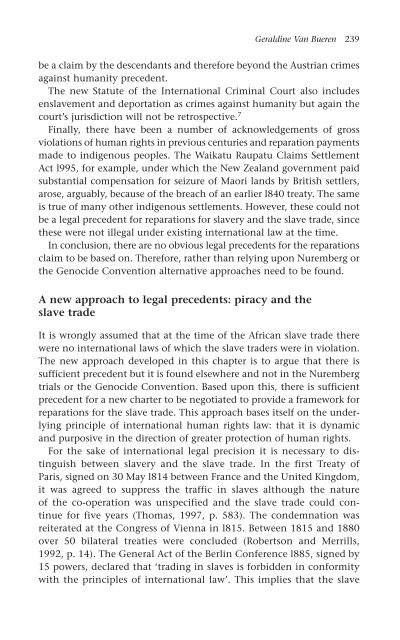3071-The political economy of new slavery
3071-The political economy of new slavery
3071-The political economy of new slavery
Create successful ePaper yourself
Turn your PDF publications into a flip-book with our unique Google optimized e-Paper software.
Geraldine Van Bueren 239<br />
be a claim by the descendants and therefore beyond the Austrian crimes<br />
against humanity precedent.<br />
<strong>The</strong> <strong>new</strong> Statute <strong>of</strong> the International Criminal Court also includes<br />
enslavement and deportation as crimes against humanity but again the<br />
court’s jurisdiction will not be retrospective. 7<br />
Finally, there have been a number <strong>of</strong> acknowledgements <strong>of</strong> gross<br />
violations <strong>of</strong> human rights in previous centuries and reparation payments<br />
made to indigenous peoples. <strong>The</strong> Waikatu Raupatu Claims Settlement<br />
Act l995, for example, under which the New Zealand government paid<br />
substantial compensation for seizure <strong>of</strong> Maori lands by British settlers,<br />
arose, arguably, because <strong>of</strong> the breach <strong>of</strong> an earlier l840 treaty. <strong>The</strong> same<br />
is true <strong>of</strong> many other indigenous settlements. However, these could not<br />
be a legal precedent for reparations for <strong>slavery</strong> and the slave trade, since<br />
these were not illegal under existing international law at the time.<br />
In conclusion, there are no obvious legal precedents for the reparations<br />
claim to be based on. <strong>The</strong>refore, rather than relying upon Nuremberg or<br />
the Genocide Convention alternative approaches need to be found.<br />
A <strong>new</strong> approach to legal precedents: piracy and the<br />
slave trade<br />
It is wrongly assumed that at the time <strong>of</strong> the African slave trade there<br />
were no international laws <strong>of</strong> which the slave traders were in violation.<br />
<strong>The</strong> <strong>new</strong> approach developed in this chapter is to argue that there is<br />
sufficient precedent but it is found elsewhere and not in the Nuremberg<br />
trials or the Genocide Convention. Based upon this, there is sufficient<br />
precedent for a <strong>new</strong> charter to be negotiated to provide a framework for<br />
reparations for the slave trade. This approach bases itself on the underlying<br />
principle <strong>of</strong> international human rights law: that it is dynamic<br />
and purposive in the direction <strong>of</strong> greater protection <strong>of</strong> human rights.<br />
For the sake <strong>of</strong> international legal precision it is necessary to distinguish<br />
between <strong>slavery</strong> and the slave trade. In the first Treaty <strong>of</strong><br />
Paris, signed on 30 May l814 between France and the United Kingdom,<br />
it was agreed to suppress the traffic in slaves although the nature<br />
<strong>of</strong> the co-operation was unspecified and the slave trade could continue<br />
for five years (Thomas, 1997, p. 583). <strong>The</strong> condemnation was<br />
reiterated at the Congress <strong>of</strong> Vienna in l815. Between 1815 and 1880<br />
over 50 bilateral treaties were concluded (Robertson and Merrills,<br />
1992, p. 14). <strong>The</strong> General Act <strong>of</strong> the Berlin Conference l885, signed by<br />
15 powers, declared that ‘trading in slaves is forbidden in conformity<br />
with the principles <strong>of</strong> international law’. This implies that the slave


